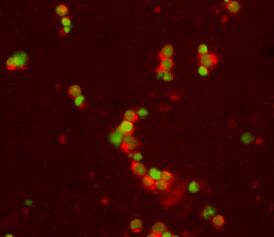Mouse CD30/TNFRSF8 Antibody
R&D Systems, part of Bio-Techne | Catalog # AF852


Key Product Details
Species Reactivity
Validated:
Mouse
Cited:
Mouse
Applications
Validated:
Agonist Activity, Immunocytochemistry, Western Blot
Cited:
Immunohistochemistry-Paraffin
Label
Unconjugated
Antibody Source
Polyclonal Goat IgG
Product Specifications
Immunogen
Mouse myeloma cell line NS0-derived recombinant mouse CD30/TNFRSF8
Phe19-Thr281
Accession # Q60846
Phe19-Thr281
Accession # Q60846
Specificity
Detects CD30/TNFRSF8 in direct ELISAs and Western blots.
Clonality
Polyclonal
Host
Goat
Isotype
IgG
Endotoxin Level
<0.10 EU per 1 μg of the antibody by the LAL method.
Scientific Data Images for Mouse CD30/TNFRSF8 Antibody
CD30/TNFRSF8 in Mouse Splenocytes.
CD30/TNFRSF8 was detected in immersion fixed mouse splenocytes using 15 µg/mL Goat Anti-Mouse CD30/TNFRSF8 Antigen Affinity-purified Polyclonal Antibody (Catalog # AF852) for 3 hours at room temperature. Cells were stained (red) and counterstained (green). View our protocol for Fluorescent ICC Staining of Non-adherent Cells.Applications for Mouse CD30/TNFRSF8 Antibody
Application
Recommended Usage
Agonist Activity
Measured by its ability to stimulate mouse splenic B cell proliferation in the presence of IL-4 and IL-5. Shanebeck K.D. et al. (1995) Eur. J. Immunol. 25:2147.
The ED50 for this effect is typically 1‑3 µg/mL.
The ED50 for this effect is typically 1‑3 µg/mL.
Immunocytochemistry
5-15 µg/mL
Sample: Immersion fixed mouse splenocytes
Sample: Immersion fixed mouse splenocytes
Western Blot
0.1 µg/mL
Sample: Recombinant Mouse CD30/TNFRSF8 Fc Chimera (Catalog # 852-CD)
Sample: Recombinant Mouse CD30/TNFRSF8 Fc Chimera (Catalog # 852-CD)
Formulation, Preparation, and Storage
Purification
Antigen Affinity-purified
Reconstitution
Reconstitute at 0.2 mg/mL in sterile PBS. For liquid material, refer to CoA for concentration.
Formulation
Lyophilized from a 0.2 μm filtered solution in PBS with Trehalose. *Small pack size (SP) is supplied either lyophilized or as a 0.2 µm filtered solution in PBS.
Shipping
Lyophilized product is shipped at ambient temperature. Liquid small pack size (-SP) is shipped with polar packs. Upon receipt, store immediately at the temperature recommended below.
Stability & Storage
Use a manual defrost freezer and avoid repeated freeze-thaw cycles.
- 12 months from date of receipt, -20 to -70 °C as supplied.
- 1 month, 2 to 8 °C under sterile conditions after reconstitution.
- 6 months, -20 to -70 °C under sterile conditions after reconstitution.
Background: CD30/TNFRSF8
References
- Kennedy, M.K. et al. (2006) Immunology 118:143.
- Tarkowski, M. (2003) Curr. Opin. Hematol. 10:267.
- Bowen, M.A. et al. (1996) J. Immunol. 156:442.
- Hamann, D. et al. (1996) J. Immunol. 156:1387.
- Shanebeck, S.D. et al. (1995) Eur. J. Immunol. 25:2147.
- Gruss, H.-J. et al. (1994) Blood 83:2045.
- Oflzoglu E. et al. (2009) Adv. Exp. Med. Biol. 647:174.
- Del Prete, G. et al. (1995) J. Exp. Med. 182:1655.
- Harlin, H. et al. (2002) J. Immunol. 169:2451.
- Amakawa, R. et al. (1996) Cell 84:551.
- Chiarle, R. et al. (1999) J. Immunol. 163:194.
- Vinante, F. et al. (2002) Blood 99:52.
- Hansen, H.P. et al. (1995) Int. J. Cancer 63:750.
- Hansen, H.P. et al. (2000) J. Immunol. 165:6703.
- Hargreaves, P.G. and A. Al-Shamkhani (2002) Eur. J. Immunol. 32:163.
Alternate Names
CD30, TNFRSF8
Gene Symbol
TNFRSF8
UniProt
Additional CD30/TNFRSF8 Products
Product Documents for Mouse CD30/TNFRSF8 Antibody
Product Specific Notices for Mouse CD30/TNFRSF8 Antibody
For research use only
